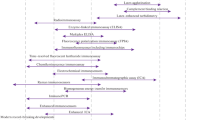Abstract
Immunoassays exploit the highly selective interaction between antibodies and antigens to provide a vital method for biomolecule detection at low concentrations. Developers and practitioners of immunoassays have long known that non-specific binding often restricts immunoassay limits of quantification (LOQs). Aside from non-specific binding, most efforts by analytical chemists to reduce the LOQ for these techniques have focused on improving the signal amplification methods and minimizing the limitations of the detection system. However, with detection technology now capable of sensing single-fluorescence molecules, this approach is unlikely to lead to dramatic improvements in the future. Here, fundamental interactions based on the law of mass action are analytically connected to signal generation, replacing the four- and five-parameter fittings commercially used to approximate sigmoidal immunoassay curves and allowing quantitative consideration of non-specific binding and statistical limitations in order to understand the ultimate detection capabilities of immunoassays. The restrictions imposed on limits of quantification by instrumental noise, non-specific binding, and counting statistics are discussed based on equilibrium relations for a sandwich immunoassay. Understanding the maximal capabilities of immunoassays for each of these regimes can greatly assist in the development and evaluation of immunoassay platforms. While many studies suggest that single molecule detection is possible through immunoassay techniques, here, it is demonstrated that the fundamental limit of quantification (precision of 10 % or better) for an immunoassay is approximately 131 molecules and this limit is based on fundamental and unavoidable statistical limitations.





Similar content being viewed by others
Abbreviations
- LOD:
-
Limit of detection
- NSB:
-
Non-specific binding
- MSN:
-
Molecular shot noise
- LOQ:
-
Limit of quantification
- P4-P5:
-
Four- and five-parameter model
References
Brown EN, McDermott TJ, Bloch KJ, McCollom AD (1996) Clin Chem 42:893–903
Ekins R, Kelso D (2011) Clin Chem 57:372–375
Cook DB, Selt CH (1993) Clin Chem 39:965–971
Miles LEM, Hales CN (1968) Nature 219:186–189
Ishikawa E, Hashida S, Kohno T, Hirota K (1990) Clin Chim Acta 194:51–72
Ylander PJ, Hanninen P (2010) Biophys Chem 151:105–110
Klenin KV, Kusnezow W, Langowski J (2005) J Chem Phys 122:214715-1–214715-11
Rodbard D, Feldman Y (1978) Immunochemistry 15:71–76
Sadana A, Chen Z (1996) Biosens Bioelectron 11:17–33
Werthen M, Nygren H (1988) J Immunol Methods 115:71–78
Nygren H, Werthen M, Stenberg M (1987) J Immunol Methods 101:63–71
Nygren H, Stenberg M (1989) Immunology 66:321–327
Stenberg M, Nygren H (1985) J Theor Biol 113:589–597
Stenberg M, Stiblert L, Nygren H (1986) J Theor Biol 120:129–140
Beumer T, Haarbosch P, Carpay W (1996) Anal Chem 68:1375–1380
Pesce AJ, Michael JG (1992) J Immunol Methods 150:111–119
Stenberg M, Nygren H (1988) J Immunol Methods 113:3–15
Rodbard D, Feldman Y, Jaffe ML, Miles LEM (1978) Immunochemistry 15:77–82
Jackson TM, Ekins RP (1986) J Immunol Methods 87:13–20, T. R
Glass N, Ohmura, Saiki H (2007) Anal Chem 79:1954–1960
Seth J (1990) Clin Chem 36:178
Kalman SM, Clark DR, Moses LE (1984) Clin Chem 30:515–517
Currie LA (1968) Anal Chem 40:586–593
Yalow RS, Berson SA (1959) Nature 184:1648–1649
Hassibi A, Vikalo H, Hajimiri A (2007) J Appl Phys 102:014909-1–014909-12
Rissin DM, Kan CW, Campbell TG, Howes SC, Fournier DR, Song L, Piech T, Patel PP, Chang L, Rivnak AJ, Ferrell EP, Randall JD, Provuncher GK, Walt DR, Duffy DC (2010) Nat Biotechnol 28:595–599
Tessler LA, Mitra RD (2011) Proteomics 11:4731–4735
Schmidt R, Jacak J, Schirwitz C, Stadler V, Michel G, Marme N, Schutz GJ, Hoheisel JD, Knemeyer JP (2011) J Proteome Res 10:1316–1322
Hashida S, Ishikawa E (1990) J Biochem 108:960–964
Ohmura N, Lackie SJ, Saiki H (2001) Anal Chem 73:3392–3399
Chang L, Rissin DM, Fournier DR, Piech T, Patel PP, Wilson DH, Duffy DC (2012) J Immunol Methods 378:102–115
Shalev A, Greenberg AH, McAlpine PJ (1980) J Immunol Meth 38:125–139
Harris CC, Yolken RH, Krokan H, Hsu IC (1979) Proc Natl Acad Sci U S A 76:5336–5339
Hungerford JM, Christian GD (1986) Anal Chem 58:2567–2568
Diamandis EP, Christopoulos TK (1996) Immunoassay (theory of immunoassays CH 3) 25-49.
Ezan E, Tiberghien C, Dray F (1991) Clin Chem 37:226–230
Yalow R (1961) Diabetes 10:339–344
Ractliffe JF (1967) Elements of mathematical statistics (the normal distribution CH 7) 51-68
Ewing GW (1968) Chemical instrumentation: XXXIX. Signal to noise optimization in chemistry. Chem Educ 45(7):A533–A544
Johnson JB (1928) Thermal agitation of electricity in conductors. Phys Rev 32(1):97–109
Nyquist H (1928) Thermal agitation of electric charge in conductors. Phys Rev 32(1):110–113
Voet D, Voet JG, Pratt CW (2008) Fundamentals of Biochemistry (Antibodies Section 7.3) 209–215
Guo Y, Harel O, Little RJ (2010) Epidemiology 21:S10–S16
O’Malley AJ, Deely JJ (2003) Aust NZ J Stat 45:43–65
Acknowledgments
This work was supported by a grant (5R21EB010191-02) from the National Institutes of Health.
Conflict of interest
The authors declare that they have no competing interests.
Author information
Authors and Affiliations
Corresponding author
Electronic supplementary material
Below is the link to the electronic supplementary material.
ESM 1
(PDF 162 kb)
Rights and permissions
About this article
Cite this article
Woolley, C.F., Hayes, M.A., Mahanti, P. et al. Theoretical limitations of quantification for noncompetitive sandwich immunoassays. Anal Bioanal Chem 407, 8605–8615 (2015). https://doi.org/10.1007/s00216-015-9018-2
Received:
Revised:
Accepted:
Published:
Issue Date:
DOI: https://doi.org/10.1007/s00216-015-9018-2




